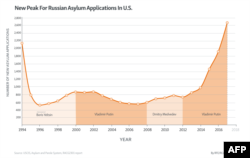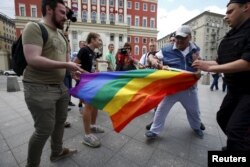The number of asylum applications by Russian citizens in the United States hit a 24-year high in 2017, jumping nearly 40 percent from the previous year and continuing an upward march that began after Russian President Vladimir Putin returned to the Kremlin in 2012.
U.S. authorities received 2,664 new asylum applications from Russian nationals in the fiscal year ending on Sept. 30, a 39-percent increase compared to 2016.
RFE/RL obtained the 2017 statistics, which have yet to be released publicly, under a Freedom Of Information Act request filed with U.S. Citizenship and Immigration Services (USCIS).
The 2017 figure is more than double the number of first-time applications by Russians since 2012, when Putin was elected to a third presidential term after serving four years as prime minister. It also eclipsed the previous high according to USCIS data for post-Soviet Russia, set in 1994 with 2,127 first-time asylum applications by Russians.
Putin has been accused by critics of overseeing a mounting crackdown on dissent — including against the political opposition and businesspeople not in step with the Kremlin — and fostering stigmatization of sexual minorities since he regained the presidency.
A flashpoint of criticism has been law signed by Putin in 2013, a year into his third term, that banned disseminating "propaganda of nontraditional sexual relations" to minors, and which has been widely denounced as discriminatory — an accusation the Kremlin rejects.
The USCIS statistics do not indicate the basis for the asylum claims, though successful applicants must demonstrate "persecution or a well-founded fear of persecution" in their home country "on account of race, religion, nationality, membership in a particular social group, or political opinion."
Rights activists and immigration attorneys say the surge in the number of Russian asylum applications in the United States has been driven in part by the 2013 law concerning sexual minorities.
In a ruling last year, the European Court of Human Rights said that by enacting such laws, Russian authorities "reinforce stigma and prejudice and encourage homophobia, which is incompatible with the notions of equality, pluralism, and tolerance inherent in a democratic society."
'I had to leave'
Vlad, a gay Russian applicant in his 30s, told RFE/RL that he was simply looking to move somewhere where he could live "more freely," and that a lawyer suggested U.S. asylum as an option. He said his family is not aware that he is gay and asked that his last name not be published.
Vlad said in a telephone interview that a man he had dated in Russia was killed after leaving a gay club, and that he believes militant antigay thugs may have been responsible. He said he had also been harassed in Russia due to his sexual orientation.
"I understood that I had to leave, and that it’s unlikely I could live peacefully and find a partner in Russia," Vlad said, adding that he applied for U.S. asylum in December 2016.
Lyosha Gorshkov, a New York-based activist and asylee who heads RUSA LGBT, a support network for Russian-speaking sexual minorities and their families, told RFE/RL that since 2016 there has also been a "huge influx" of HIV-positive gay men from Russia seeking U.S. asylum.
Gorshkov attributes this to significant difficulties in obtaining medication in Russia to treat HIV.
Canada and several European countries last year began helping gay men from Chechnya obtain asylum following revelations about an alleged campaign of torture and murder targeting gay Chechens in the mainly Muslim republic in southern Russia.
Russian activists say gay Chechens face difficulties in obtaining a U.S. visa that would allow them to travel to the United States and apply for asylum.
Wendy Barlow, an immigration attorney with The Law Offices of Grinberg & Segal in New York, told RFE/RL that her firm had "a couple of consultations with members of the LGBT (lesbian, gay, bisexual, and transgender) community from Chechnya" last year, but had not represented any.
'Getting shaken down'
Russian entrepreneurs are also seeking political asylum in the United States, claiming they were targeted by Russian authorities, according to U.S.-based attorneys handling such cases.
New York-based attorney Boris Palant said that most of his Russian asylum cases involve "persecution in the form of a fabricated criminal case."
"One is a banker, but most of them are young businessmen," Palant told RFE/RL.
Another New York-based attorney, Andrew Johnson, said his firm took on 25-30 new cases involving Russian asylum applicants in 2017. Half of those involved "straight political opinion," while 35 percent concerned politically tinged "business-related" cases, Johnson said.
He said his firm had clients who say they were "getting shaken down on their business dealings merely because they are partisan and anti-Putin, and funding or being involved in another political party."
In some cases, even apolitical asylum seekers say they were accused by Russian authorities of antigovernment behavior after they rebuffed requests for bribes and other official pressure, Johnson said.
Putin was recently elected by a landslide to a fourth term as president in a ballot decried by opposition activists as tightly controlled political theater.
During his March 1 state-of-the-nation address, delivered at the height of the campaign period, Putin said that Russia must "get rid of everything that enables corrupt officials and law enforcement officers to pressure businesses."
Both Putin and his stopgap predecessor, current Prime Minister Dmitry Medvedev, have made similar calls in the past.
'Hidden' migration
The 2,664 new Russian asylum applications in the United States last year — a 268-percent increase since 2012 — represent, of course, a tiny percentage of Russia's total population of 144 million.
But that figure did place the United States ahead of every European Union country except Germany in terms of Russian first-time asylum applications in 2017. According to full-year EU immigration data for 2017, Germany received 4,885 of the more than 12,600 first-time Russian asylum applications in the 28-member bloc.
Around 90 percent of Russian citizens who apply for asylum in Germany are ethnic Chechens who enter the EU on the Belarusian-Polish border, according to Olga Gulina, head of the Berlin-based Institute on Migration Policy.
In the United States, "there is a lot more variety among (Russian) people seeking asylum," Gulina told RFE/RL.
Gulina said, however, that "humanitarian migration" by Russians to Europe is "hidden" to a significant degree.
"People prefer not to apply for asylum. They prefer to look for other mechanisms," including educational programs, Gulina said.
A study published in January by researchers at the Russian Presidential Academy of National Economy and Public Administration estimated that annually, around 100,000 Russians have left their homeland in recent years. Around 40 percent of those people have higher educations, according to the study.
There searchers surveyed highly qualified Russians who moved to the West — and stayed there — after 2010. A majority of the respondents said they left due to economic difficulties that snowballed in 2014, when flagging oil prices and Western sanctions over Russia's expansionism in Ukraine battered the Russian economy.
A quarter of the respondents said they left due to the "political situation" in Russia, including "disappointment" after the 2012 election that brought Putin back to the Kremlin and the "events of 2014," when Russia annexed Ukraine’s Crimean Peninsula and war between Kyiv’s forces and Russia-backed separatists erupted in eastern Ukraine.






